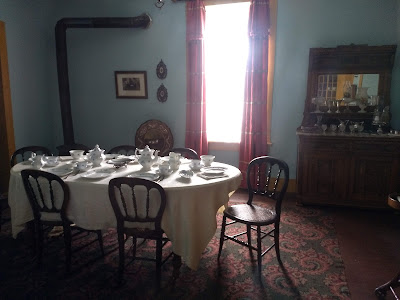Gering, NE to Dorrance, KS
September 19-24
On Friday, September 20 we took a morning trip to Chimney Rock National Historical Site. Many emigrants mentioned this landmark in their diaries.
Here is a list of what the pioneers would have taken with them on this several month journey.
It would have had to fit in a space about 4'x10'. I have to wonder if they had known what they were about to experience if they would have left.
Most people walked the entire distance.
On Saturday, September 21 we drove to North Platte, KS. On the way, off in the distance, was Courthouse Rock and Jail Rock, also mentioned many times in the emigrant's diaries.
We stayed at the I-80 Lakeside Campground for two nights. John was headed outside to take a picture of the campground but got sidetracked and forgot. Sorry!
On Sunday, September 22 we went to the Golden Spike Tower in North Platte.
The tower overlooks Bailey Yard. Covering 2,850 acres, each day the yard manages 10,000 railroad cars. Of those, 3,000 are sorted to make sure the cargo reaches its final destination. It's huge!
They have two 'humps' to sort the cars. A train drives over the hump heading west (because west is a higher elevation than east). When all the cars have gone over it stops. Cars are disconnected and roll down the hump to be connected with the proper train. It's amazing to watch. They do have a live cam at https://goldenspiketower.com/bailey-yard/live-cam/ which is fun to watch too.
After lunch we went to the Lincoln County Historical Museum. You may have heard the story of the North Platte Canteen. Women who lived in North Platte during World War II met every train that went through the station and served the soldiers sandwiches, fruit, coffee and cakes. I had heard of it but didn't remember that this was where it happened.
That's a big coffee pot!
There was a sign on the front doors of the museum saying: "These three doors plus two in the rear were recovered from the 1916 Union Pacific Depot in North Platte, NE when it was razed in 1973. The kitchen and dining room of the depot was taken over by the ladies of North Platte and surrounding area in World War II and was known as the canteen to all the service men and women."
This shield was from the Union Pacific Depot from 1918 to 1973, when it was torn down.
I have heard of ration stamps during World War II but had never seen any.
Behind the museum there was an old 'town'. Buildings had been moved from their original location to the museum.
The barn and windmill.
Fort McPherson Cabin and Maxwell Jail.
The Fredrickson House was a Sears & Roebuck house.
There was the schoolhouse and the church.
There was a young man in the blacksmith shop making a knife.
There were a lot of other buildings too. A very interesting museum. I would recommend the Golden Spike Tower and the museum.
On Monday, September 23 we drove from Nebraska to Kansas. I-80 parallels the Oregon/California/Pony Express trails. I was surprised to see oil wells among the corn fields in both states.
We're at Minooka Park Campground on Wilson Lake near Dorrance, KS. It's a Corp of Engineers park and there's hardly anyone here. Our site backs up to the lake and we've decided to stay until Sunday.
While we're here there's nothing to see and no place to go. It's sort of a nice change for a few days.
Roving on...
The heavens declare the
glory of God, and the firmament shows His handiwork. Psalm 19:1
























































































































